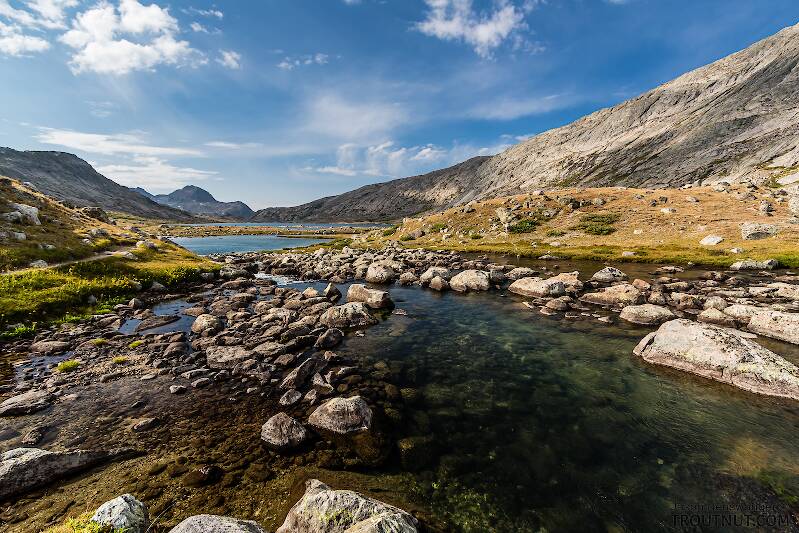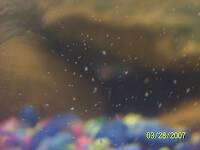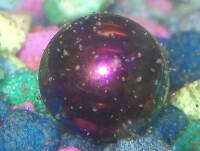
Blue-winged Olives
Baetis
Tiny Baetis mayflies are perhaps the most commonly encountered and imitated by anglers on all American trout streams due to their great abundance, widespread distribution, and trout-friendly emergence habits.
Featured on the forum

This wild-looking little thing completely puzzled me. At first I was thinking beetle or month larva, until I got a look at the pictures on the computer screen. I made a couple of incorrect guesses before entomologist Greg Courtney pointed me in the right direction with Psychodidae. He suggested a possible genus of Thornburghiella, but could not rule out some other members of the tribe Pericomini.

Troutnut is a project started in 2003 by salmonid ecologist Jason "Troutnut" Neuswanger to help anglers and
fly tyers unabashedly embrace the entomological side of the sport. Learn more about Troutnut or
support the project for an enhanced experience here.
Damon on Oct 29, 2016October 29th, 2016, 9:08 am EDT
Damon Nez - Northeastern Tennessee
October 29, 2016
I’ve never requested information from an online source before, so I hope you can take a moment to respond to my request.
I live in eastern Tennessee and fly fish the Clinch River near Knoxville, the tailwater below Norris Dam. For several weeks now I’ve noticed trout taking small white insects at or near the surface of the water. I tried to capture one of the insects for closer inspection to no avail.
The insects are somewhat numerous and very tiny, appearing white or cream in color while in flight at or near the surface. Some seem to be dappling the surface and flying up again. One alit on my flyrod for a few seconds and it appeared to be a tiny caddis (Micro Caddis?). While at rest on my flyrod it’s wings were folded closed over its back and it resembled a caddis, but very, very small. Maybe a size #26, 28 hook.
The trout were sipping, gulping and leaping on these insects, but I and other anglers were unable to catch the fish. We were using very small Elk Hair Caddis patterns, but even these in size #18 and #20 seemed to big.
It seemed to me the fish were attacking these insects even when they were in flight within a couple of inches of the surface, and so the fish were jumping, sometimes out of the water, to sink and drown the little flies.
The flies were not drifting on the surface, but instead were dappling and flying up again. Female micro caddis ovipositing?
What sort of technique could a fly fisher use to attract a strike considering the tiny adult insects were NOT drifting on the surface, but dappling instead?
I’ve thought about Japanese Tenkara fishing where the fly is sometimes dappled instead of drifted, but I’m not very familiar with that and I’m not sure it would work in this case anyway.
I have read a very brief passage on a website about dappling caddises in which the author mentioned using a "hop and bounce" cast. I'd never heard of that before, but, from what I could ascertain, it refers to a cast where the angler casts directly downstream, waits for the line and leader to straighten out in the current, then gives the rod a thump to send a wave down the line and leader causing the fly to hop or bounce. Repeating this several times during the cast might induce a strike.
Could anyone tell me, or direct me to a good source of information, on a technique that might work? Or more descriptive information on a Hop and Bounce cast? I’ve researched the Internet exhaustively and found many articles on caddis fishing, but nothing that describes this phenomenon or how to fish it.
Thanks.
October 29, 2016
I’ve never requested information from an online source before, so I hope you can take a moment to respond to my request.
I live in eastern Tennessee and fly fish the Clinch River near Knoxville, the tailwater below Norris Dam. For several weeks now I’ve noticed trout taking small white insects at or near the surface of the water. I tried to capture one of the insects for closer inspection to no avail.
The insects are somewhat numerous and very tiny, appearing white or cream in color while in flight at or near the surface. Some seem to be dappling the surface and flying up again. One alit on my flyrod for a few seconds and it appeared to be a tiny caddis (Micro Caddis?). While at rest on my flyrod it’s wings were folded closed over its back and it resembled a caddis, but very, very small. Maybe a size #26, 28 hook.
The trout were sipping, gulping and leaping on these insects, but I and other anglers were unable to catch the fish. We were using very small Elk Hair Caddis patterns, but even these in size #18 and #20 seemed to big.
It seemed to me the fish were attacking these insects even when they were in flight within a couple of inches of the surface, and so the fish were jumping, sometimes out of the water, to sink and drown the little flies.
The flies were not drifting on the surface, but instead were dappling and flying up again. Female micro caddis ovipositing?
What sort of technique could a fly fisher use to attract a strike considering the tiny adult insects were NOT drifting on the surface, but dappling instead?
I’ve thought about Japanese Tenkara fishing where the fly is sometimes dappled instead of drifted, but I’m not very familiar with that and I’m not sure it would work in this case anyway.
I have read a very brief passage on a website about dappling caddises in which the author mentioned using a "hop and bounce" cast. I'd never heard of that before, but, from what I could ascertain, it refers to a cast where the angler casts directly downstream, waits for the line and leader to straighten out in the current, then gives the rod a thump to send a wave down the line and leader causing the fly to hop or bounce. Repeating this several times during the cast might induce a strike.
Could anyone tell me, or direct me to a good source of information, on a technique that might work? Or more descriptive information on a Hop and Bounce cast? I’ve researched the Internet exhaustively and found many articles on caddis fishing, but nothing that describes this phenomenon or how to fish it.
Thanks.
TimCat on Oct 31, 2016October 31st, 2016, 9:46 am EDT
I've tried "skating" caddis for brook trout, but found that the dead drift worked better, even though caddis seemed to be dropping eggs on the surface. The movement can certainly attract the fish, but due to their opportunistic nature, I think they'd have no problem gulping down a helpless bug on the dead-drift.
To skate a caddis make sure you have plenty of floatant on the fly and you can/should probably grease the leader up about 2 ft. as well. Just twitch and strip in small amounts. I think dapping would probably mimic the insect behavior better though. The problem with that is you can't dap a fly 30 ft out...
If you don't have anything to match the size I would just use a griffith's gnat personally, like fishing a midge hatch. I can't tie anything smaller than 18 really (although I have tied some simple nymphs in 20), so I just use a griffith's gnat for any hatch with those tiny flies unless I buy some trico patterns and have them with me while the tricos are falling in the morning.
I think keeping it simple usually works the best for me.
Let us know how it goes next time you run into this, and what you try out!
To skate a caddis make sure you have plenty of floatant on the fly and you can/should probably grease the leader up about 2 ft. as well. Just twitch and strip in small amounts. I think dapping would probably mimic the insect behavior better though. The problem with that is you can't dap a fly 30 ft out...
If you don't have anything to match the size I would just use a griffith's gnat personally, like fishing a midge hatch. I can't tie anything smaller than 18 really (although I have tied some simple nymphs in 20), so I just use a griffith's gnat for any hatch with those tiny flies unless I buy some trico patterns and have them with me while the tricos are falling in the morning.
I think keeping it simple usually works the best for me.
Let us know how it goes next time you run into this, and what you try out!
"If I'm not going to catch anything, then I 'd rather not catch anything on flies" - Bob Lawless
Oldredbarn on Oct 31, 2016October 31st, 2016, 3:06 pm EDT
The trout were sipping, gulping and leaping on these insects, but I and other anglers were unable to catch the fish. We were using very small Elk Hair Caddis patterns, but even these in size #18 and #20 seemed to big.
What sort of technique could a fly fisher use to attract a strike considering the tiny adult insects were NOT drifting on the surface, but dappling instead?
Sometimes, size does matter...:) Your considering a "micro-caddis" is more than likely dead on...The ovi-positing females occasionally get stuck to the surface when they attempt to free themselves from their eggs. The "bulging" rises were probably to these...Out west rather large fish in the Madison will do classic porpoising rises to these trapped caddis.
The important thing is the shear numbers during events like this. It doesn't make logical sense to us as observers that a fish would pass up a larger meal, your size 18, for something so small, but they are keyed into these bugs in an almost routine manner...Selective.
Dabbling, in my experience, works on small brook trout...Raise your rod high and skate the fly across the surface, then occasionally drop the rod and let the fly float...It takes a little practice to make it look life like and not put the nicer fish down. Palmered flies like the old Elk Hair work nice...It needs to ride on top.
Sometimes nature is just flat out better at it than we can ever hope to be...Sometimes the fish win.
Size to me is number one, then a design that closely imitates the naturals behavior...In this situation really small classic wets will work and spent caddis patterns...This imitates the flies that get stuck to the surface film and don't rise back up after.
Hope this helps?
Spence
"Even when my best efforts fail it's a satisfying challenge, and that, after all, is the essence of fly fishing." -Chauncy Lively
"Envy not the man who lives beside the river, but the man the river flows through." Joseph T Heywood
"Envy not the man who lives beside the river, but the man the river flows through." Joseph T Heywood
TNEAL on Nov 2, 2016November 2nd, 2016, 9:57 am EDT
I was not on hand so it's hard to know for sure, but at times when fish are coming out of the water like that they are chasing emerging pupa and their momentum carries them out.Soft hackled wets have served me well under those conditions.
Damon on Nov 6, 2016November 6th, 2016, 5:38 am EST
Thanks for all your comments to my post on Adult Caddis Technique.
I think Spence hit it closest. He mentioned using a long rod and reaching out to dapple the very small adult caddis imitation on the surface and letting it drift as well.
These trout on the Clinch River northeast of Knoxville, TN are finicky and very selective. But most all of us anglers are getting skunked (or nearly so) every time we go out these past few weeks.
The caddis are micro caddis and very, very tiny. I don't know how anyone could tie an imitation on a hook size 28 to 32. But they are dappling and not drifting.
I'll have to experiment with a dappling technique if I can figure out how to do it without spooking the fish.
Thanks again,
Damon
I think Spence hit it closest. He mentioned using a long rod and reaching out to dapple the very small adult caddis imitation on the surface and letting it drift as well.
These trout on the Clinch River northeast of Knoxville, TN are finicky and very selective. But most all of us anglers are getting skunked (or nearly so) every time we go out these past few weeks.
The caddis are micro caddis and very, very tiny. I don't know how anyone could tie an imitation on a hook size 28 to 32. But they are dappling and not drifting.
I'll have to experiment with a dappling technique if I can figure out how to do it without spooking the fish.
Thanks again,
Damon
Oldredbarn on Nov 6, 2016November 6th, 2016, 9:25 am EST
they are chasing emerging pupa
Yes...Maybe if you can get it to ride just below the surface film, but little flies are just to light and it may be hard to replicate the naturals behavior.
Sorry Tim about the "size does matter" comment above...I know you Grayling Boys hate to toss anything smaller that a size 10, and these tiny caddis are just a nuisance. ;)
Spence
"Even when my best efforts fail it's a satisfying challenge, and that, after all, is the essence of fly fishing." -Chauncy Lively
"Envy not the man who lives beside the river, but the man the river flows through." Joseph T Heywood
"Envy not the man who lives beside the river, but the man the river flows through." Joseph T Heywood
Jmd123 on Nov 6, 2016November 6th, 2016, 11:33 am EST
"I know you Grayling Boys hate to toss anything smaller that a size 10, and these tiny caddis are just a nuisance. ;)"
Ditto for me, Spence. I haven't often encountered fish feeding on really tiny (#20 and smaller) flies of any persuasion, at least not on streams. There are times though that they are rising to some "mystery" thing that isn't visible, especially on Reid Lake and at times [REDACTED] Pond, and once in a while on a stream. Sometimes they won't hit anything I'm throwing at them (i.e., #16 or larger), but at others a #10 grasshopper is something they can't resist, especially if you throw one on stillwaters and then twitch it...doesn't matter what they're actually feeding on, they just blast it, had them doing it even on Friday afternoon at Reid Lake. They are quite possibly feeding on emerging midge or microcaddis pupae, as they make the smallest little dimples when feeding...not true when they hit the hoppers, though! So like Spence says, they will often attack a much larger target even if their prey is tiny...but not always!
Tim mentioned rainbows clearing the water when hitting emerging pupae. I see a lot of jumping little rainbows on the Pine, but they also do that when attacking a #12 caddis or #10 hopper, and about half the time they miss the fly completely. The other half of the time they do grab it on the way back down!
Jonathon
Ditto for me, Spence. I haven't often encountered fish feeding on really tiny (#20 and smaller) flies of any persuasion, at least not on streams. There are times though that they are rising to some "mystery" thing that isn't visible, especially on Reid Lake and at times [REDACTED] Pond, and once in a while on a stream. Sometimes they won't hit anything I'm throwing at them (i.e., #16 or larger), but at others a #10 grasshopper is something they can't resist, especially if you throw one on stillwaters and then twitch it...doesn't matter what they're actually feeding on, they just blast it, had them doing it even on Friday afternoon at Reid Lake. They are quite possibly feeding on emerging midge or microcaddis pupae, as they make the smallest little dimples when feeding...not true when they hit the hoppers, though! So like Spence says, they will often attack a much larger target even if their prey is tiny...but not always!
Tim mentioned rainbows clearing the water when hitting emerging pupae. I see a lot of jumping little rainbows on the Pine, but they also do that when attacking a #12 caddis or #10 hopper, and about half the time they miss the fly completely. The other half of the time they do grab it on the way back down!
Jonathon
No matter how big the one you just caught is, there's always a bigger one out there somewhere...
Quick Reply
Related Discussions
Topic
Replies
Last Reply
2
Nov 4, 2012
by Aszat
by Aszat







